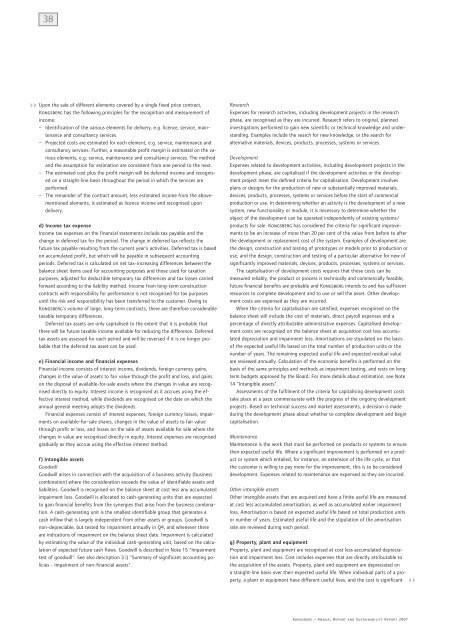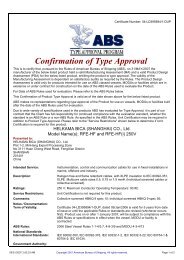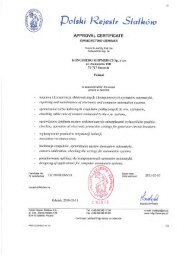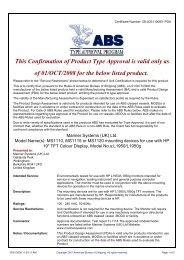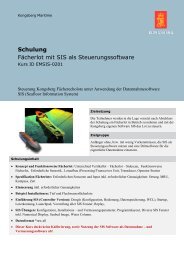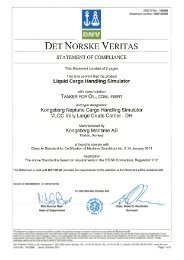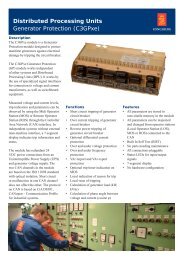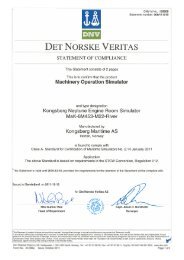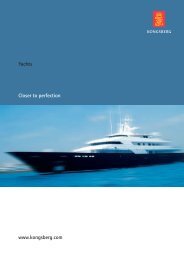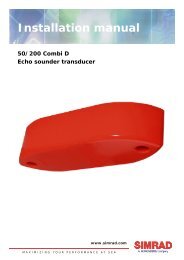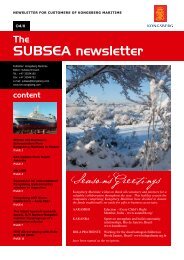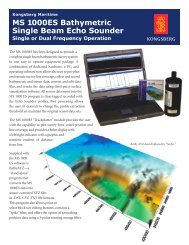Report - Kongsberg Gruppen 2007 - Kongsberg Maritime ...
Report - Kongsberg Gruppen 2007 - Kongsberg Maritime ...
Report - Kongsberg Gruppen 2007 - Kongsberg Maritime ...
You also want an ePaper? Increase the reach of your titles
YUMPU automatically turns print PDFs into web optimized ePapers that Google loves.
38<br />
Upon the sale of different elements covered by a single fixed price contract,<br />
<strong>Kongsberg</strong> has the following principles for the recognition and measurement of<br />
income:<br />
– Identification of the various elements for delivery, e.g. licence, service, main -<br />
tenance and consultancy services.<br />
– Projected costs are estimated for each element, e.g. service, maintenance and<br />
consultancy services. Further, a reasonable profit margin is estimated on the various<br />
elements, e.g. service, maintenance and consultancy services. The method<br />
and the assumption for estimation are consistent from one period to the next.<br />
– The estimated cost plus the profit margin will be deferred income and recognis -<br />
ed on a straight-line basis throughout the period in which the services are<br />
performed.<br />
– The remainder of the contract amount, less estimated income from the abovementioned<br />
elements, is estimated as licence income and recognised upon<br />
delivery.<br />
d) Income tax expense<br />
Income tax expenses on the financial statements include tax payable and the<br />
change in deferred tax for the period. The change in deferred tax reflects the<br />
fu ture tax payable resulting from the current year's activities. Deferred tax is based<br />
on accumulated profit, but which will be payable in subsequent accounting<br />
periods. Deferred tax is calculated on net tax-increasing differences between the<br />
balance sheet items used for accounting purposes and those used for taxation<br />
purposes, adjusted for deductible temporary tax differences and tax losses carried<br />
forward according to the liability method. Income from long-term construction<br />
contracts with responsi bility for performance is not recognised for tax purposes<br />
until the risk and responsibility has been transferred to the customer. Owing to<br />
<strong>Kongsberg</strong>'s volume of large, long-term contracts, there are therefore considerable<br />
taxable temporary differences.<br />
Deferred tax assets are only capitalised to the extent that it is probable that<br />
there will be future taxable income available for reducing the difference. Deferred<br />
tax assets are assessed for each period and will be reversed if it is no longer probable<br />
that the deferred tax asset can be used.<br />
e) Financial income and financial expenses<br />
Financial income consists of interest income, dividends, foreign currency gains,<br />
changes in the value of assets to fair value through the profit and loss, and gains<br />
on the disposal of available-for-sale assets where the changes in value are recog -<br />
nised directly to equity. Interest income is recognised as it accrues using the ef -<br />
fective interest method, while dividends are recognised on the date on which the<br />
annual general meeting adopts the dividends.<br />
Financial expenses consist of interest expenses, foreign currency losses, impairments<br />
on available-for-sale shares, changes in the value of assets to fair value<br />
through profit or loss, and losses on the sale of assets available for sale where the<br />
changes in value are recognised directly in equity. Interest expenses are recognised<br />
gradually as they accrue using the effective interest method.<br />
f) Intangible assets<br />
Goodwill<br />
Goodwill arises in connection with the acquisition of a business activity (business<br />
combination) where the consideration exceeds the value of identifiable assets and<br />
liabilities. Goodwill is recognised on the balance sheet at cost less any accumulated<br />
impairment loss. Goodwill is allocated to cash-generating units that are expected<br />
to gain financial benefits from the synergies that arise from the business combination.<br />
A cash-generating unit is the smallest identifiable group that generates a<br />
cash inflow that is largely independent from other assets or groups. Goodwill is<br />
non-depreciable, but tested for impairment annually in Q4, and when ever there<br />
are indications of impairment on the balance sheet date. Impairment is calculated<br />
by estimating the value of the individual cash-generating unit, based on the calcula<br />
tion of expected future cash flows. Goodwill is described in Note 15 "Impairment<br />
test of goodwill". See also description 3 i) "Summary of significant accounting policies<br />
- Impairment of non-financial assets".<br />
Research<br />
Expenses for research activities, including development projects in the research<br />
phase, are recognised as they are incurred. Research refers to original, planned<br />
investigations performed to gain new scientific or technical knowledge and understanding.<br />
Examples include the search for new knowledge, or the search for<br />
alternative materials, devices, products, processes, systems or services.<br />
Development<br />
Expenses related to development activities, including development projects in the<br />
development phase, are capitalised if the development activities or the development<br />
project meet the defined criteria for capitalisation. Development involves<br />
plans or designs for the production of new or substantially improved materials,<br />
devices, products, processes, systems or services before the start of commercial<br />
production or use. In determining wheth er an activity is the development of a new<br />
system, new functionality or module, it is necessary to determine whether the<br />
object of the development can be operat ed independently of existing systems/<br />
products for sale. <strong>Kongsberg</strong> has considered the criteria for significant improvements<br />
to be an increase of more than 20 per cent of the value from before to after<br />
the development or replacement cost of the system. Examples of development are<br />
the design, construction and testing of prototypes or models prior to production or<br />
use, and the design, construction and testing of a particular alternative for new of<br />
significantly improved materials, devices, products, processes, systems or services.<br />
The capitalisation of development costs requires that those costs can be<br />
measured reliably, the product or process is technically and commercially feasible,<br />
future financial benefits are probable and <strong>Kongsberg</strong> intends to and has sufficient<br />
re sources to complete development and to use or sell the asset. Other development<br />
costs are expensed as they are incurred.<br />
When the criteria for capitalisation are satisfied, expenses recognised on the<br />
balance sheet will include the cost of materials, direct payroll expenses and a<br />
percentage of directly attributable administrative expenses. Capitalised development<br />
costs are recognised on the balance sheet at acquisition cost less accumu -<br />
lated depreciation and impairment loss. Amortisations are stipulated on the basis<br />
of the expected useful life based on the total number of production units or the<br />
number of years. The remaining expected useful life and expected residual value<br />
are reviewed annually. Calculation of the economic benefits is performed on the<br />
basis of the same principles and methods as impairment testing, and rests on longterm<br />
budgets approved by the Board. For more details about estimation, see Note<br />
14 "Intangible assets".<br />
Assessments of the fulfilment of the criteria for capitalising development costs<br />
take place at a pace commensurate with the progress of the ongoing development<br />
projects. Based on technical success and market assessments, a decision is made<br />
during the development phase about whether to complete development and begin<br />
capitalisation.<br />
Maintenance<br />
Maintenance is the work that must be performed on products or systems to ensure<br />
their expected useful life. Where a significant improvement is performed on a prod -<br />
uct or system which entailed, for instance, an extension of the life cycle, or that<br />
the customer is willing to pay more for the improvement, this is to be consider ed<br />
development. Expenses related to maintenance are expensed as they are incurred.<br />
Other intangible assets<br />
Other intangible assets that are acquired and have a finite useful life are measured<br />
at cost less accumulated amortisation, as well as accumulated earlier impairment<br />
loss. Amortisation is based on expected useful life based on total production units<br />
or number of years. Estimated useful life and the stipulation of the amortisation<br />
rate are reviewed during each period.<br />
g) Property, plant and equipment<br />
Property, plant and equipment are recognised at cost less accumulated deprecia -<br />
tion and impairment loss. Cost includes expenses that are directly attributable to<br />
the acquisition of the assets. Property, plant and equipment are depreciated on<br />
a straight-line basis over their expected useful life. When individual parts of a property,<br />
a plant or equipment have different useful lives, and the cost is significant<br />
<strong>Kongsberg</strong> – Annual <strong>Report</strong> and Sustainability <strong>Report</strong> <strong>2007</strong>


